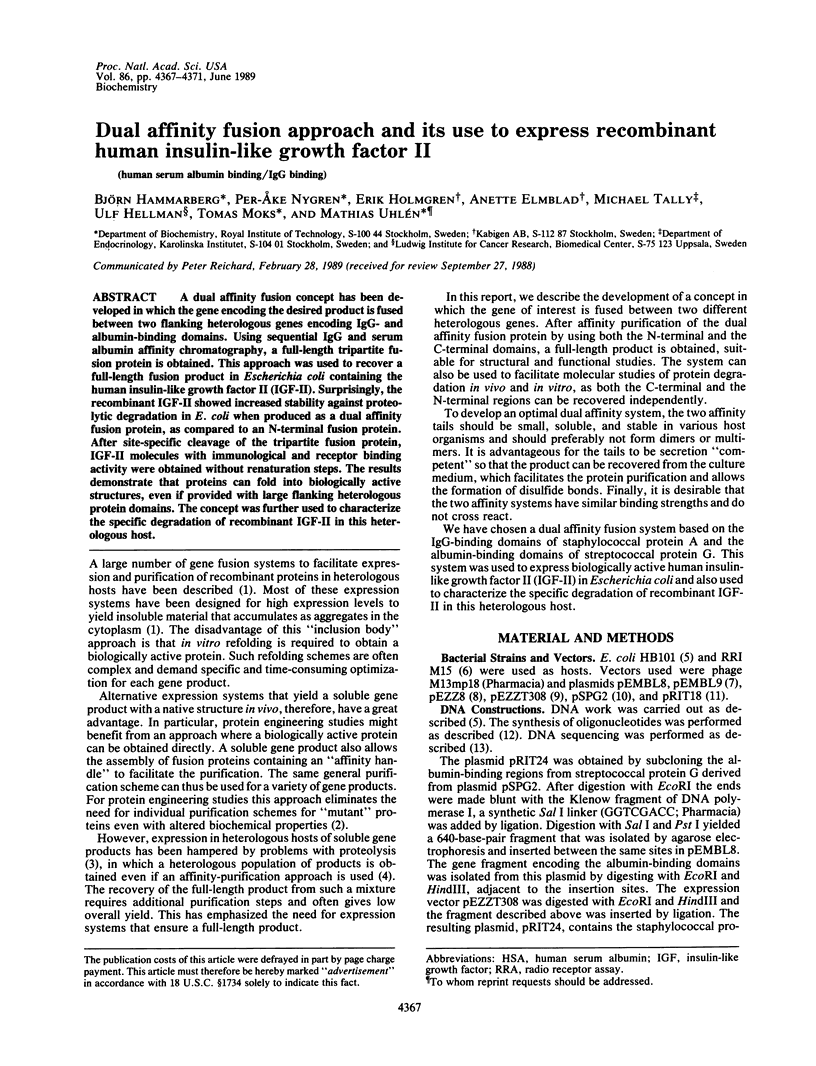Abstract
A dual affinity fusion concept has been developed in which the gene encoding the desired product is fused between two flanking heterologous genes encoding IgG- and albumin-binding domains. Using sequential IgG and serum albumin affinity chromatography, a full-length tripartite fusion protein is obtained. This approach was used to recover a full-length fusion product in Escherichia coli containing the human insulin-like growth factor II (IGF-II). Surprisingly, the recombinant IGF-II showed increased stability against proteolytic degradation in E. coli when produced as a dual affinity fusion protein, as compared to an N-terminal fusion protein. After site-specific cleavage of the tripartite fusion protein, IGF-II molecules with immunological and receptor binding activity were obtained without renaturation steps. The results demonstrate that proteins can fold into biologically active structures, even if provided with large flanking heterologous protein domains. The concept was further used to characterize the specific degradation of recombinant IGF-II in this heterologous host.
Full text
PDF




Images in this article
Selected References
These references are in PubMed. This may not be the complete list of references from this article.
- Abrahmsén L., Moks T., Nilsson B., Hellman U., Uhlén M. Analysis of signals for secretion in the staphylococcal protein A gene. EMBO J. 1985 Dec 30;4(13B):3901–3906. doi: 10.1002/j.1460-2075.1985.tb04164.x. [DOI] [PMC free article] [PubMed] [Google Scholar]
- Carter P., Wells J. A. Engineering enzyme specificity by "substrate-assisted catalysis". Science. 1987 Jul 24;237(4813):394–399. doi: 10.1126/science.3299704. [DOI] [PubMed] [Google Scholar]
- Dente L., Cesareni G., Cortese R. pEMBL: a new family of single stranded plasmids. Nucleic Acids Res. 1983 Mar 25;11(6):1645–1655. doi: 10.1093/nar/11.6.1645. [DOI] [PMC free article] [PubMed] [Google Scholar]
- Elmblad A., Josephson S., Palm G. Synthesis of mixed oligodeoxyribonucleotides following the solid phase method. Nucleic Acids Res. 1982 May 25;10(10):3291–3301. doi: 10.1093/nar/10.10.3291. [DOI] [PMC free article] [PubMed] [Google Scholar]
- Enberg G., Hall K. Immunoreactive IGF-II in serum of healthy subjects and patients with growth hormone disturbances and uraemia. Acta Endocrinol (Copenh) 1984 Oct;107(2):164–170. doi: 10.1530/acta.0.1070164. [DOI] [PubMed] [Google Scholar]
- Grodberg J., Dunn J. J. ompT encodes the Escherichia coli outer membrane protease that cleaves T7 RNA polymerase during purification. J Bacteriol. 1988 Mar;170(3):1245–1253. doi: 10.1128/jb.170.3.1245-1253.1988. [DOI] [PMC free article] [PubMed] [Google Scholar]
- Guss B., Eliasson M., Olsson A., Uhlén M., Frej A. K., Jörnvall H., Flock J. I., Lindberg M. Structure of the IgG-binding regions of streptococcal protein G. EMBO J. 1986 Jul;5(7):1567–1575. doi: 10.1002/j.1460-2075.1986.tb04398.x. [DOI] [PMC free article] [PubMed] [Google Scholar]
- Langley K. E., Villarejo M. R., Fowler A. V., Zamenhof P. J., Zabin I. Molecular basis of beta-galactosidase alpha-complementation. Proc Natl Acad Sci U S A. 1975 Apr;72(4):1254–1257. doi: 10.1073/pnas.72.4.1254. [DOI] [PMC free article] [PubMed] [Google Scholar]
- Löwenadler B., Jansson B., Paleus S., Holmgren E., Nilsson B., Moks T., Palm G., Josephson S., Philipson L., Uhlén M. A gene fusion system for generating antibodies against short peptides. Gene. 1987;58(1):87–97. doi: 10.1016/0378-1119(87)90032-1. [DOI] [PubMed] [Google Scholar]
- Marston F. A. The purification of eukaryotic polypeptides synthesized in Escherichia coli. Biochem J. 1986 Nov 15;240(1):1–12. doi: 10.1042/bj2400001. [DOI] [PMC free article] [PubMed] [Google Scholar]
- Moks T., Abrahmsén L., Holmgren E., Bilich M., Olsson A., Uhlén M., Pohl G., Sterky C., Hultberg H., Josephson S. Expression of human insulin-like growth factor I in bacteria: use of optimized gene fusion vectors to facilitate protein purification. Biochemistry. 1987 Aug 25;26(17):5239–5244. doi: 10.1021/bi00391a005. [DOI] [PubMed] [Google Scholar]
- Nossal N. G., Heppel L. A. The release of enzymes by osmotic shock from Escherichia coli in exponential phase. J Biol Chem. 1966 Jul 10;241(13):3055–3062. [PubMed] [Google Scholar]
- Nygren P. A., Eliasson M., Abrahmsén L., Uhlén M., Palmcrantz E. Analysis and use of the serum albumin binding domains of streptococcal protein G. J Mol Recognit. 1988 Apr;1(2):69–74. doi: 10.1002/jmr.300010204. [DOI] [PubMed] [Google Scholar]
- Olson H., Lind P., Pohl G., Henrichson C., Mutt V., Jörnvall H., Josephson S., Uhlén M., Lake M. Production of a biologically active variant form of recombinant human secretin. Peptides. 1988 Mar-Apr;9(2):301–307. doi: 10.1016/0196-9781(88)90264-1. [DOI] [PubMed] [Google Scholar]
- Olsson A., Uhlén M. Sequencing and heterologous expression of the gene encoding penicillin V amidase from Bacillus sphaericus. Gene. 1986;45(2):175–181. doi: 10.1016/0378-1119(86)90252-0. [DOI] [PubMed] [Google Scholar]
- Takano K., Hall K., Ritzén M., Iselius L., Sievertsson H. Somatomedin A in human serum, determined by radioreceptor assay. Acta Endocrinol (Copenh) 1976 Jul;82(3):449–459. doi: 10.1530/acta.0.0820449. [DOI] [PubMed] [Google Scholar]
- Zumstein P. P., Lüthi C., Humbel R. E. Amino acid sequence of a variant pro-form of insulin-like growth factor II. Proc Natl Acad Sci U S A. 1985 May;82(10):3169–3172. doi: 10.1073/pnas.82.10.3169. [DOI] [PMC free article] [PubMed] [Google Scholar]





